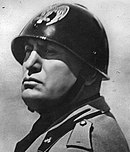Republican Fascist Party
Republican Fascist Party Partito Fascista Repubblicano | |
|---|---|
 | |
| Abbreviation | PFR |
| Duce | Benito Mussolini |
| Secretary | Alessandro Pavolini |
| Founded | 13 September 1943 |
| Dissolved | 2 May 1945[1] |
| Preceded by | National Fascist Party |
| Succeeded by | Italian Social Movement (de facto) |
| Headquarters | Palazzo Castani, Milan |
| Newspaper | Il Lavoro Fascista |
| Paramilitary wing | Black Brigades (from 1944) |
| Membership | 900,000 (1943 est.) |
| Ideology | Italian fascism Pro-Nazism[2][3][4][5][6] |
| Political position | Far-right[7][8] |
| Colours | Black[9] |
| Anthem | "Giovinezza"[10] |
| Party flag | |
 | |
The Republican Fascist Party (
.History

After the Nazi-engineered Gran Sasso raid liberated Mussolini, the National Fascist Party (PNF) was revived on 13 September 1943 as the Republican Fascist Party (PFR) and as the single party of the Northern and Nazi-protected Italian Social Republic, informally known as the Salò Republic. Its secretary was Alessandro Pavolini.
Due to the strong control of the Germans, the party's power in the context of the Republic of Salò was always very limited. To obviate this inherent weakness, the party tried to obtain the support of the few population strata who still sympathised with fascism.[11] In the provinces under the control of the Germans it was organised into three entities called Administrative, Assistance, and Political.[12] The Assistance, also called the National Fascist Assistance Body, was formed in early October 1943. In the minds of the party leaders, the Assistance was to be a continuation of the powerful cadres of militants and volunteers of the former National Fascist Party.[12]
The PFR did not outlast Mussolini's execution and the disappearance of the Salò state in April 1945. However, it inspired the creation of the Italian Social Movement (MSI)[13] and the MSI has been seen as the successor to the PFR and the PNF.[14] The MSI was formed by former Fascist leaders and veterans of the National Republican Army of the Salò republic.[15] The party tried to modernise and revise fascist doctrine into a more moderate and sophisticated direction.[16]
Giuseppe Pizzirani led the PFR organisation in Rome until April 1944, when he was named Deputy Secretary of the national party organisation.[17]
Ideology
The PFR sought to reconnect the new party with pre-1922 radical fascism. This move attracted parts of the fascist 'Old Guard', who had been sidelined after Mussolini had come to power in 1922. The new party was, however, internally divided, with different internal tendencies vying for Mussolini's support, and whilst the PFR revived some of the early revolutionary fascist discourse, it did not return to the anti-clerical positions of the early fascist movement.[18]
In addition, the party promoted a
.Secretary of the PFR
- Alessandro Pavolini (15 November 1943 – 28 April 1945)
National Congress
- 1st National Congress – Verona, 14–15 November 1943
References
- ^ 22 December 1947 (Banned)
- ^ Arrigo Petacco, Il comunista in camicia nera: Nicola Bombacci tra Lenin e Mussolini, Milano, Mondadori, 1997.
- ^ Roberto D'Angeli, Storia del Partito Fascista Repubblicano, Roma, Castelvecchi, 2016.
- ^ Guerrazzi, Amedeo Osti. "9 From Fascism to the Italian Civil War: The Republican Fascist’s Identity from 1943 to 1945." Italy and the Second World War. Brill, 2018. 203-223.
- ^ Roggi, Alessandra. "The role of ideology in the Italian Social Republic (1943-1945)." The role of ideology in the Italian Social Republic (1943-1945) (2015): 676-687.
- ^ Berardi, Silvio. "L’impossibile dialogo tra repubblicani fascisti e repubblicani storici (ottobre 1943-aprile 1944)." MONDO CONTEMPORANEO 2015/1 (2015).
- ISBN 0394716582.
- ^ Raniolo, Francesco (2013). I partiti politici. Roma: Editori Laterza. pp. 116–117.
- OCLC 60393965.
- ISBN 0-8223-3063-6. p. 69.
- OCLC 1091262426.
- ^ a b Dianella Gagliani, Il Partito nel Fascismo Repubblicano Delle Origini: Una Prima Messa a Punto, in Rivista di Storia Contemporanea, vol. 23, n. 1/2, 1º gennaio 1994, pp. 130-169.
- ISBN 978-0-203-99472-6.
- ^ Levy, 1996, p. 188.
- ^ Ignazi, 1998, p. 157.
- ISBN 978-0-415-07224-3.
- ISBN 978-1-4725-0789-1.
- ISBN 978-1-134-81904-1.
- ^ Griffin, 2000, pp. 31–35
- ^ Kallis, 2008, p. 515
- ^ Grčić, Joseph. Ethics and Political Theory (Lanham, Maryland: University of America, Inc, 2000) p. 120.
- Griffin, Roger and Matthew Feldman, eds., Fascism: Fascism and Culture (London and New York: Routledge, 2004) p. 185.
- Jackson J. Spielvogel. Western Civilization. Wadsworth, Cengage Learning, 2012. p. 935.
- ^ Stanley G. Payne. A History of Fascism, 1914–1945. p. 106.
- ^ Roger Griffin, "Nationalism" in Cyprian Blamires, ed., World Fascism: A Historical Encyclopedia, vol. 2 (Santa Barbara, California: ABC-CLIO, 2006), pp. 451–53.
- ISBN 978-0-8018-9427-5.
- ^ L' antisemitismo nella Repubblica Sociale Italiana. Repertorio delle fonti conservate all'Archivio centrale dello Stato, Libreria Universitaria
- ^ La Repubblica sociale italiana e la persecuzione degli ebrei
- ^ Jim Powell, "The Economic Leadership Secrets of Benito Mussolini", Forbes, 22 February 2012
- ^ Eugen Weber. The Western Tradition: From the Renaissance to the present. Heath, 1972. Pp. 791.
- ^ Stanislao G. Pugliese. Fascism, anti-fascism, and the resistance in Italy: 1919 to the present. Oxford, England, UK: Rowman & Littlefield Publishers, Inc., 2004. pp. 43–44.
- ^ Rimbotti, 2018

